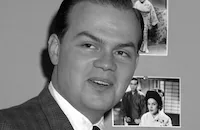Bridge to the Sun

Brief Synopsis
Cast & Crew
Etienne Périer
Carroll Baker
James Shigeta
James Yagi
Sean Garrison
Ruth Masters
Film Details
Technical Specs

Synopsis
In 1930, while vacationing in Washington, D. C., Tennessee-born Gwen Harold falls in love with and marries Japanese diplomat Hidenari (Terry) Terasaki, despite her family's objections. When the Japanese attack Pearl Harbor in 1941, Gwen, Terry, and their daughter, Mako, are sent to Japan in exchange for American diplomats stationed there. Because of Terry's long opposition to the war party, he is stripped of all his stations and carefully watched by the Kempei-tai, the secret police. Furthermore, Gwen, torn between allegiance to her native country and affection for her new home, is often treated with hostility by the Japanese. An additional problem occurs when a friend of Mako's is killed during an Allied bombing, and Mako becomes embittered against her mother's country. When Japan eventually surrenders, Terry is appointed to act as a liaison between Emperor Hirohito and General MacArthur; but the war years have taken a heavy toll upon Terry's health, and he discovers that he has only a short time to live. To spare his wife and child, he suggests that they return to the United States where he will join them later. Though Gwen has learned of Terry's fatal illness, she respects her husband's wishes, and she and Mako leave Japan.

Director

Etienne Périer
Cast

Carroll Baker

James Shigeta

James Yagi

Sean Garrison
Ruth Masters
Nori Elisabeth Hermann
Emi Florence Hirsch
Hiroshi Tomono
Kyoko Takahashi
Yoshiko Hiromura
Lee Payant
Crew
Georges Auric
Jacques Bar
Robert Bouladoux
Jean-jacques Caziot
Francine Corteggiani
René Daudin
Haven Falconer
Takashi Fugie
Olivier Gérard
Kenji Inagawa
Monique Isnardon
Robert Isnardon
Jacques Juranville
Charles Kaufman
Bill Kelly
Seiichi Kizuka
Jacques Metehen
Hiroshi Mizutani
Hiroshi Moroishi
Raymond Picon-borel
Mary Roche-faye
Jacques Rouffio
Marcel Weiss

Videos
Movie Clip



Trailer
Film Details
Technical Specs

Articles
Bridge to the Sun
Gwen Terasaki's autobiography -- depicting the events of her marriage to Japanese diplomat Hidenari Terasaki, who opposed his country's entry into World War II -- became a best seller in 1957. After a whirlwind courtship in the '30s, the Terasakis had moved to his native land, returning to the U.S. in 1941 as he attempted to negotiate a peaceful settlement prior to the war. During the war, she returned to Japan when he was deported. There she was often treated as one of the enemy, even by her own daughter, and the two suffered almost unendurable poverty.
The MGM project was assigned to Jacques Bar, who had done uncredited work on Federico Fellini's I Vitelloni (1953) before working on a string of international successes. He assigned the direction to the Belgian Etienne Perier. A student of Henri-George Clouzot, Robert Siodmak and Jean Cocteau, Perier had previously worked with Bar on Murder at 45 R.P.M. (1959). He would be praised by some critics for his atmospheric direction of Bridge to the Sun and his ability to bring together location footage shot in Washington, D.C., and Japan with studio work filmed in Paris.
For the film's leads, MGM insisted on actors with some name recognition in the U.S. Hawaii-born James Shigeta had first made an impression as a singer on Ted Mack's Amateur Hour, going on to a series of musical guest appearances and nightclub work. His breakthrough on screen came with Sam Fuller's The Crimson Kimono (1959), playing an Asian-American police detective investigating a murder in Los Angeles' Japanese community. Hollywood took a liking to the handsome actor, making him the first Asian leading man to be promoted as a star since Sessue Hayakawa's days in silent films. With the film capital in a period of transition, however, there were few bankable projects available to him, nor was there much likelihood of his being cast in a major role originally written for a Caucasian actor. After starring in the musical Flower Drum Song (1961), he moved into television guest shots and eventually found himself consigned to supporting roles.
Actor's Studio alumnus Carroll Baker had been groomed as the next Marilyn Monroe at Warner Bros., where she earned an Oscar® nomination starring in Baby Doll and joined the all-star cast of Giant (both 1956). Her rebelliousness began to cost her roles, however, including the leads in The Three Faces of Eve (1957) and Cat on a Hot Tin Roof (1958). She also had appeared in husband Jack Garfein's experimental film Something Wild (1961), whose box-office failure almost halted her career.
Bridge to the Sun didn't help Baker either. Despite a highly touted premiere in Gwen Terasaki's native Johnson City, Tennessee, it failed at the box office, with U.S. critics complaining that the intriguing premise had been treated as a dreary domestic drama. It did better in Europe, where it was nominated for Best Picture at the Venice Film Festival, and Baker was nominated for Best Actress. Although both lost, MGM at least let her keep the Givenchy gown she had bought for the occasion. Baker's career would not revive until she tried for a more provocative image with a Playboy layout (she was one of the first Hollywood leading ladies to pose for them) and the sex-charged melodrama The Carpetbaggers (1964).
Producer: Jacques Bar
Director: Etienne Perier
Screenplay: Charles Kaufman
Based on the autobiography by Gwen Terasaki
Cinematography: Marcel Weiss, Seiichi Kizuka, Bill Kelly
Score: Georges Auric
Art Direction: Hiroshi Mizutani
Principal Cast: Carroll Baker (Gwen Terasaki), James Shigeta (Hidenari Terasaki), James Yagi (Hara), Tetzuro Tamba (Jiro), Hiroshi Tomono (Ashi), Nori Elisabeth Hermann, Emi Florence Hirsch (Mako Tersaki), Sean Garrison (Fred Tyson). BW-113m.
by Frank Miller

Bridge to the Sun
Quotes
Trivia
Notes
Location scenes filmed in Japan and Washington, D. C. Opened in Paris in March 1964 as Le pont vers le soleil; running times: 115 and 88 min.

Miscellaneous Notes
Released in United States October 4, 1961
Released in United States Summer August 7, 1961
Released in United States Summer August 7, 1961
Released in United States October 4, 1961














